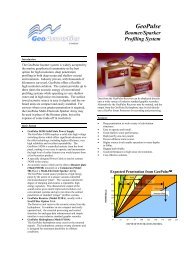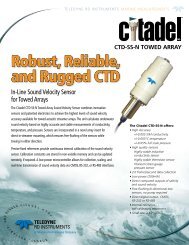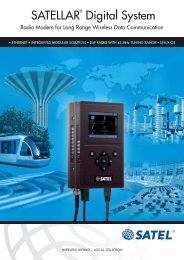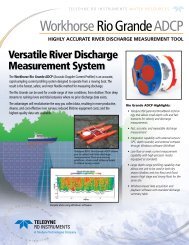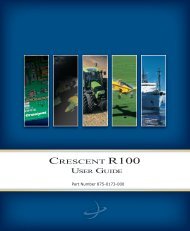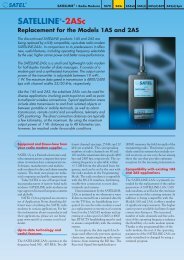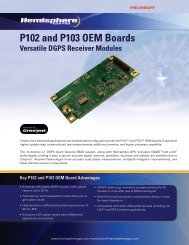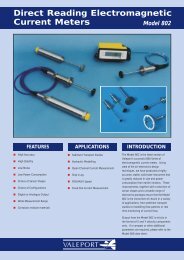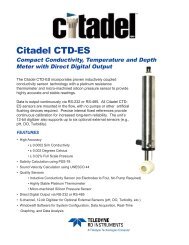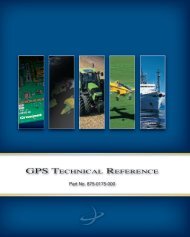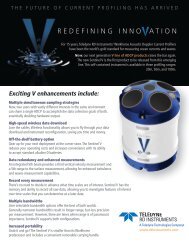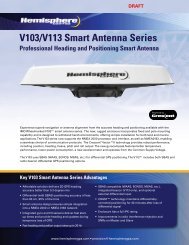Fundamentals of High Resolution Seismic Surveying
Fundamentals of High Resolution Seismic Surveying
Fundamentals of High Resolution Seismic Surveying
You also want an ePaper? Increase the reach of your titles
YUMPU automatically turns print PDFs into web optimized ePapers that Google loves.
<strong>Fundamentals</strong> <strong>of</strong> <strong>High</strong> <strong>Resolution</strong><strong>Seismic</strong> <strong>Surveying</strong>Applied Acoustic Engineering LimitedGreat Yarmouth, Norfolk, UKTelephone 44 1493 440355Fax 44 1493 440720Web: Appliedacoustics.comEmail techsupport@appliedacoustics.com
<strong>Fundamentals</strong> <strong>of</strong> <strong>High</strong> <strong>Resolution</strong> <strong>Seismic</strong> <strong>Surveying</strong><strong>High</strong> <strong>Resolution</strong> Marine <strong>Seismic</strong> <strong>Surveying</strong>One <strong>of</strong> the most useful techniques in <strong>of</strong>f-shore work is the application <strong>of</strong> seismicdevices for sea floor engineering surveys. Although other manufacturers producesuch equipment, Applied Acoustic Engineering have a dominant position as asupplier <strong>of</strong> boomer and sparker systems for use <strong>of</strong>fshore, and the following textdescribes the use <strong>of</strong> the products available from our factory or our global network <strong>of</strong>agents.General Description <strong>of</strong> <strong>Seismic</strong> MethodsThe two basic seismic exploration techniques used at sea are seismic refraction andseismic reflection methods. The main difference between the two techniques is thatin refraction work, the energy arrives at the receiver after travelling through the rocklayers; whereas in reflection work, the energy is received after it has reflected fromthe subsurface layers. The following text describes the Applied Acoustic EngineeringBoomer system as a reflection system.Reflection MethodsThe Applied Acoustic EngineeringBoomer system as described consists<strong>of</strong> a towed sound source (<strong>of</strong>ten aBoomer Plate) which transmits soundenergy in the form <strong>of</strong> a short pulsetowards the seabed. This soundenergy is reflected from the seabedand the subsequent layers <strong>of</strong> soil.The reflected energy intensitydepends on the different densities <strong>of</strong>the seabed, the denser (harder) theseabed, the stronger the reflectedsignal. The reflected signal travelsback through the water to a surfacetowed hydrophone (an underwaterWaterSeabedReflective layerApplied Acoustic Engineering Limited Rev A October 1998 Page 2
microphone). The received signals are amplified, and returned to the vessel wherethey are processed and displayed.The sequence is described thus:-A transmission pulse from the boomer travels through the water at the same time as arecording sequence is started. As the signals travel in time to the seabed andsubsequent layers <strong>of</strong> soil and returns, the synchronised record displays a line <strong>of</strong> signalon a paper recorder. The line contains signals proportional in intensity (darkness) tothe strength <strong>of</strong> the reflected data. Another transmission pulse starts the sequenceagain to produce another line on the record. This sequence continues several timesper second as the equipment is towed over the seabed, resulting in a record similarto the figure above <strong>of</strong> a cross section through the seabed.<strong>Seismic</strong> reflection devices and techniques vary widely, but all have similar basiccomponents. The four basic components in any seismic reflection system are:1. A sound source that emits acoustic impulses or pressure waves. (The AA200Boomer Plate, mounted on its catamaran, or our Squid Sparker).2. An energy source to store energy for the sound source. (The CSP unit)3. A hydrophone receiver that converts the reflected acoustic signals to electricalsignals. (Streamer Hydrophones)4. A display that makes a permanent record <strong>of</strong> the reflected signals. (Comprising <strong>of</strong>the shallow seismic processor and a graphic recorder).Other electronic devices that are <strong>of</strong>ten used include analogue and digital tapestorage, PC based display and signal processing equipment etc. although they willnot be covered in this article.The function and nature <strong>of</strong> the four basic components will be considered separately.Sound Sources:In the past for example, the detonation <strong>of</strong>dynamite charges tossed overboard fromthe vessel was common. In general, thehazards <strong>of</strong> using high explosives at sea makethis technique somewhat undesirable!Commonly, boomer plates and sparkers areused. The boomer plate produces a sharp(short duration) broad spectrum pulse whichgives a good trade-<strong>of</strong>f <strong>of</strong> penetration vs.resolution. The frequency <strong>of</strong> the signal isbetween 500Hz and 10 kHz. A sparker (suchas our Squid 500) provides a lower frequencyApplied Acoustic Engineering Limited Rev A October 1998 Page 3
pulse enabling greater penetration to be achieved but at the expense <strong>of</strong> reducedresolution. Both <strong>of</strong> the above receive energy from our CSP energy source.Energy Source.The energy source required to drive aboomer or sparker must be able toconvert regular mains voltage into thehigh voltage necessary to energise thesound source. It must be able to do thissafely and reliably, and be sited in aconvenient location. It is also necessaryto avoid the generation <strong>of</strong> electricalinterference which characterised olderdesigns which do not have a ‘CE’ markand conform to the latest EUspecifications for electro-magneticcompatibility. The CSP unit has the abilityto store the amount <strong>of</strong> energy requiredfor the high intensity sound pulses whichare given by the Boomer or Sparker. The CSP is in turn connected to the boomerplate by a high voltage cable capable <strong>of</strong> safely carrying the high current (1500amperes) high voltage (3500 volt) pulse with minimal losses.Hydrophones:-Hydrophones are usually towed away from the vessel, as ship noise is reduced byseparating the active elements in the array from the ship through the use <strong>of</strong> a longtow cable. Selectivity is accomplished through having the array directional. Thehydrophones in the array are spaced such that the signals arriving along the axis arephase shifted along the length (due to the time lag between the arrivals at eachelement). Because the phase shifting takes place along the axis, the summation <strong>of</strong>the phase shifted noise from the ship is less than the summation <strong>of</strong> the coherentsignals arriving from the bottom.Another significant source <strong>of</strong> noise, tow noise, is minimised by the mechanical design<strong>of</strong> the array (the streamlining, and the addition <strong>of</strong> a tail) again the summation <strong>of</strong> thesignals on each hydrophone helps reduce noise.The ambient noise, the noise from the waveaction and the other sea noises which arepresent at all times, is reduced from thedirectional character <strong>of</strong> the hydrphone array.Since the ambient noise is essentiallyomnidirectional, the array is less sensitive toambient noise signals than to the seismicApplied Acoustic Engineering Limited Rev A October 1998 Page 4
signals which arrive normal to the array. The phase shifting further improves thesignal to noise ratio relative to the ambient noise.Streamer hydrophone towed from a boom.The towed array receives a seismic signal which is composed <strong>of</strong> two distinct parts, adirect seismic signal which is echoed from the bottom and an indirect signal which isreflected from the surface. For maximum signal strength, these two arrivals should bein phase. This in-phase arrival usually occurs when the array is towed at a depthequal to a ¼ wavelength <strong>of</strong> the signal.In deep water operations, the signals received at the array arrive from distanceswhich are large, compared to the length <strong>of</strong> the array. In such cases, the signalsarrive in phase and at times which are essentially the same. However, when thearray is used in shallow water, the path lengths from the source to the bottom and tothe separate hydrophones may be such that the arrivals are at different times andout <strong>of</strong> phase. In such cases the records would be smeared or distorted. In all cases,the Applied Acoustic Engineering hydrophones have been designed for durabilityand optimum performance with any sub-bottom pr<strong>of</strong>iler equipment.Recorder & data presentationThe recorder is the visual interface forany seismic reflection system. Inaddition to tracing a pr<strong>of</strong>ile <strong>of</strong>subsurface reflective horizons, therecorder also includes a control panelwhich allows the operator to selectoptimum repetition rate <strong>of</strong> the energysources at various recording sweeprates. Gain controls are used to varythe intensity <strong>of</strong> the traced record. Byprogramming appropriate triggeringand gating sequences, most <strong>of</strong> theundesirable background noisegenerated by the instruments and bythe ship may be eliminated.The scale <strong>of</strong> the printed record may be adjusted so that only pertinent data appearon the paper. A further refinement permits variation in the “sweep” rate (printingspeed) <strong>of</strong> the print heads that traces the permanent record. An increase in thesweep rate narrows the range <strong>of</strong> observation on the record and correspondinglyincreases the vertical exaggeration inherent in all recording systems. Sweep rate is tosome extent a misnomer nowadays, as thermal and other recorders no longer‘sweep’ mechanically.Applied Acoustic Engineering Limited Rev A October 1998 Page 5
By using the advanced features <strong>of</strong> the digital 360 shallow seismic processor, such asband pass filtering, time varied gain (TVG) and other technology, the operator canobtain the best performance for a given seismic reflection system. There is also thefacility for digital tape storage devices that records the raw signal as it enters theseismic processor. (Analogue tape recorders can also be used). This permits thereplaying <strong>of</strong> the returning signals which, when coupled to the recorder in thelaboratory, may result in a new record <strong>of</strong> a quality exceeding that <strong>of</strong> the initial recordobtained aboard ship.Applications<strong>High</strong> resolution seismic surveys areprimarily confined in theuppermost 60 metres <strong>of</strong> soil. This isthe area where most engineeringapplications take place. It isestimated that about 80% <strong>of</strong> thiswork is done in the first 15 to 20metres. Typical applicationsinclude reconnaissance geologicalsurveys, mineral exploration,foundation studies for <strong>of</strong>fshoreplatforms, and harbourdevelopment. Generally Boomersystems <strong>of</strong>fer an excellent compromise between resolution and penetration. Ifgreater penetration is required, a new generation <strong>of</strong> high quality sparkers (the Squid500 for example) <strong>of</strong>fer excellent performance, although for very deep penetration,other devices are required. If very high resolution sub bottom pr<strong>of</strong>iling is required,chirp systems can be very effective, but penetration is not as good as a boomersystem.Typical resolutions are as follows:-AA200 Boomer Plate at 200J : 10cmSquid 500 Sparker at 200 & 500J : 14 / 36 cmLimitationsThe quality <strong>of</strong> records obtained in seismic reflection studies depends greatly on thepresence <strong>of</strong> subsurface horizons which will reflect acoustic energy. Differences in soiltype, density, water content, and degree <strong>of</strong> solidification greatly influence thereflecting properties <strong>of</strong> buried layers.Applied Acoustic Engineering Limited Rev A October 1998 Page 6
There are a number <strong>of</strong> other factors that bear upon the success <strong>of</strong> a seismicreflection survey. These may be conveniently grouped into three classes; external,vessel and instrument limitations.External Limitations are those that cannot be controlled. The major external factor isweather: rough seas not only create discomfort and difficult conditions aboard ship,but cause an increase in background and aeration noises created by breakingwaves. This may reduce the quality <strong>of</strong> the records.Another problem is that <strong>of</strong> ice. It is not common in most marine surveys, but it canhamper or cancel operations on inland waters.Vessel limitations can be generally overcome by evaluating the survey requirementsand by thoroughly checking the vessel’s capabilities before the survey. In somecases, there may be electrical or mechanical interference between the ship’sequipment and the seismic instruments.Instrument limitations vary with individual systems, but in general the following factorsare inherent in all seismic reflection devices:1. The seismic records show layer thickness as a function <strong>of</strong> time, thus the truethickness may only be determined if the speed <strong>of</strong> sound through the material isknown. Accurate sound wave velocity data are seldom available, therefore layerthicknesses must be considered approximate.2. The reflecting surface does not always represent a change in the sediment type,but may only be a change in the physical character <strong>of</strong> the soil such as grain size,porosity, density, or hardness. Therefore, care should be exercised in evaluatingthe strength (darkness) <strong>of</strong> the recorded signal.3. At greater water depths, the area <strong>of</strong> sea floor receiving sound increases. Thus,records in deep water will tend to show average conditions over an area ratherthan a specific pr<strong>of</strong>ile directly below the ship.Thus a number <strong>of</strong> precautions must be taken when the records are interpreted.Applied Acoustic Engineering Limited Rev A October 1998 Page 7
The following is just a brief guide.SEISMIC RECORD INTERPRETATIONBecause the transducer is a three-dimensional sound source, some care must begiven to the interpretation <strong>of</strong> seismic pr<strong>of</strong>iling records obtained with conventionaltwo-dimensional graphic recorders. Several factors can cause spurious tracks to beintroduced into the records, and judicious analysis is <strong>of</strong>ten required to separate thespurious signals from true bottom and subbottom reflections. This is particularly true inthose instances where the bottom or subbottom traversed has considerabledeformation or anomalies.In general, there are five different types <strong>of</strong> spurious signals that may cause confusionin the strip-chart records.There are:1. Direct Arrival- the signal received directly from the sound source.2. Reflection Multiple- the repeated echo <strong>of</strong> a reflection from the bottom orsubbottom.3. Water Surface Reflection.4. Side Echoes- side reflections from irregular bottom or subbottom features.5. Point Source Reflections- reflections from single point objects that radiatereflected energy.Direct Arrival-If the distance from the sound source to the receiver hydrophone orpickup is less than twice the distance from the receiver hydrophone to the bottom,the first signal recorded after zero time line, will be the direct signal from the soundsource to the receiver. Since it will be the strongest signal recorded, it may beaccompanied by some filter ringing that will make the event appear as a series <strong>of</strong>parallel lines. The direct arrival signal can be distinguished from the reflection signal<strong>of</strong> the bottom by the following characteristics.1. The direct arrival signal will be displaced from the zero line at a distance thatcorresponds to the hydrophone-to-sound source distance, as scaled from therecord.2. The direct arrival signal trace will remain essentially parallel to the zero line,whereas the true bottom reflection line will <strong>of</strong>ten show some slope or irregularfeatures. (If the receiver hydrophone wanders in the water, this could causeadditional confusion.)If it is difficult to differentiate between the direct arrival signal and the true bottomreflection signal, or if the direct arrival signal occurs at the time that causes maskingApplied Acoustic Engineering Limited Rev A October 1998 Page 8
<strong>of</strong> the bottom reflection, changing the hydrophone to transducer distance shouldcorrect the situation.Reflection Multiples- In areas where verystrong bottom reflection signals areencountered, echoes <strong>of</strong> the strongbottom reflection signal may mask signalsfrom subbottom reflections. Reflectionmultiples may be distinguished fromsubbottom reflections by the followingcharacteristics.corresponds to the depth <strong>of</strong> water.1. The bottom reflection multiple will bespaced from the true bottomreflection at a scale distance that2. Irregular bottom features shown in the true bottom reflection will appear inexaggerated relief at the same point in the reflection multiple, as illustrated below:-3. Frequently, more than one multiple will be recorded, and a series <strong>of</strong> regularlyspaced, consecutively lighter traces will appear in the record (with irregularbottom features assuming more exaggerated appearance in consecutivetraces).Applied Acoustic Engineering Limited Rev A October 1998 Page 9
WATER SURFACE REFLECTIONS-Because the sound source acts as a point source, radiatingenergy in all directions, a portion <strong>of</strong> the pulse energy will travel upward from thesound source to the water surface and be reflected down to the hydrophone.This water surface reflection signalwill result in a trace essentiallyparallel to the zero line (allowing fordrift <strong>of</strong> the hydrophone and soundsource) at a distance that is scalableto the sound source to surface tohydrophone distance. This signaland any <strong>of</strong> its multiples can beidentified by experimenting withdifferent hydrophone and soundsource depth distances.SIDE ECHOES- In areas where there are sea-bottom irregularities or considerablestructural deformation, side effects may cause confusion. A side echo from a seabottomfeature will have only two or three cycles that will cut across the subbottomreflections at an angle. This helps to distinguish the side echo from subbottomreflections. Subbottom reflections generally will be more or less uniform becausesubbottom sedimentary layers usually have flatter, more uniform bedding features. Incomplex structural areas, <strong>of</strong>fsetting <strong>of</strong> reflections and three-dimensional modelanalysis may be necessary for a complete interpretation. However, such analysis isbeyond the scope <strong>of</strong> this paper.POINT SOURCE REFLECTIONS-The signals receivedfrom point source reflections are actuallyside-echo reflections from distinct pointobjects in the area where the traverse isbeing run. These point source objectsusually produce hyperbola-shaped signalsthat are sharpest when the point object is ina direct line with the traverse. Objects <strong>of</strong>fto one side will record lower in the recordand be <strong>of</strong> a broader pattern, a patternsimilar to that <strong>of</strong> a buried or subbottompoint source anomaly. Repeated traversesin an area will usually serve to identifyApplied Acoustic Engineering Limited Rev A October 1998 Page 10
whether a point object is below or <strong>of</strong>f to one side.Usually seismic strip-chart records can be readily interpreted and used to identifybottom and subbottom pr<strong>of</strong>ile information in light <strong>of</strong> known geological information. Inmost marine engineering applications, coring information is required for comparisonbetween geological horizons or sedimentary layers to seismic records.Applied Acoustic Engineering Limited Rev A October 1998 Page 11




